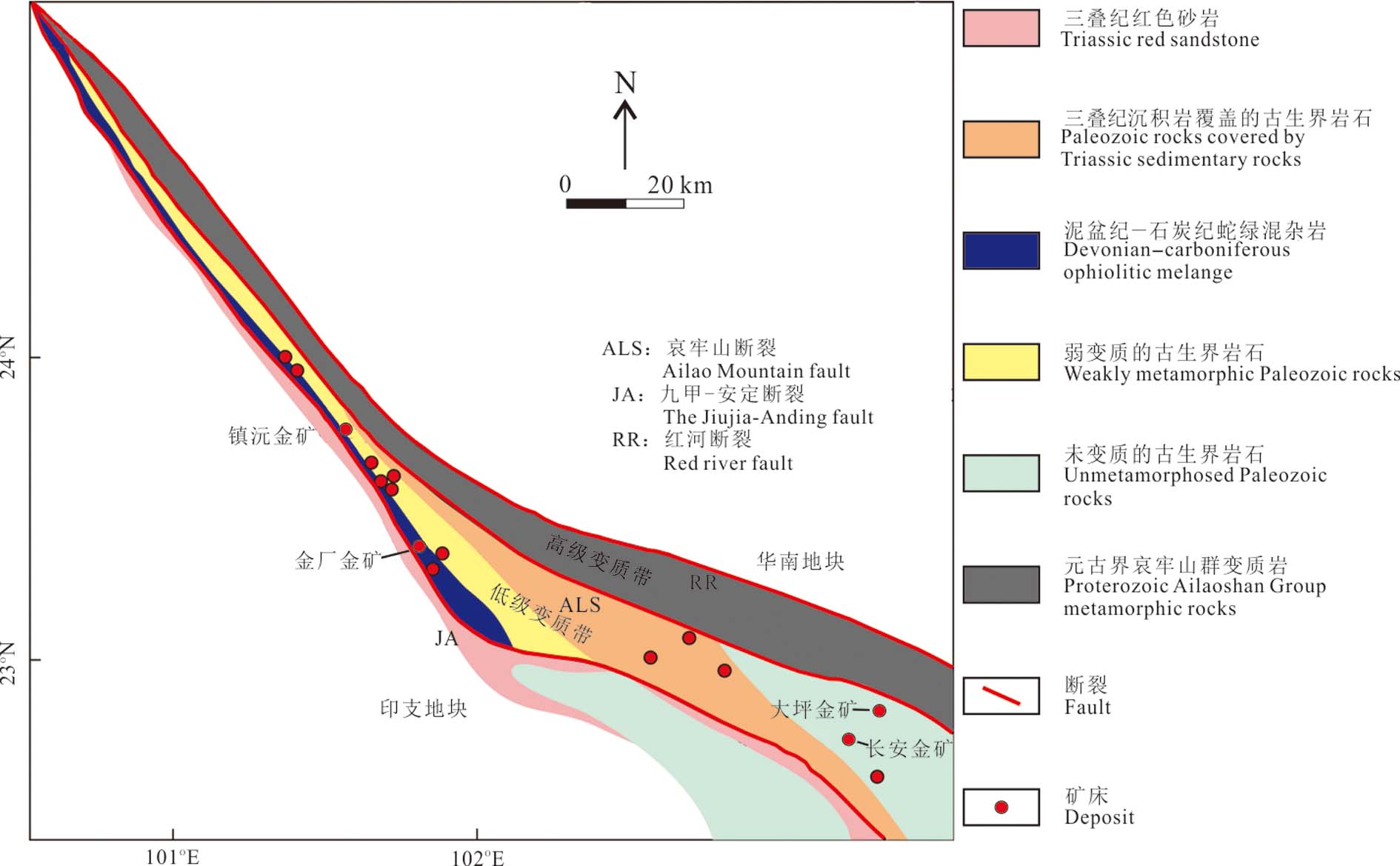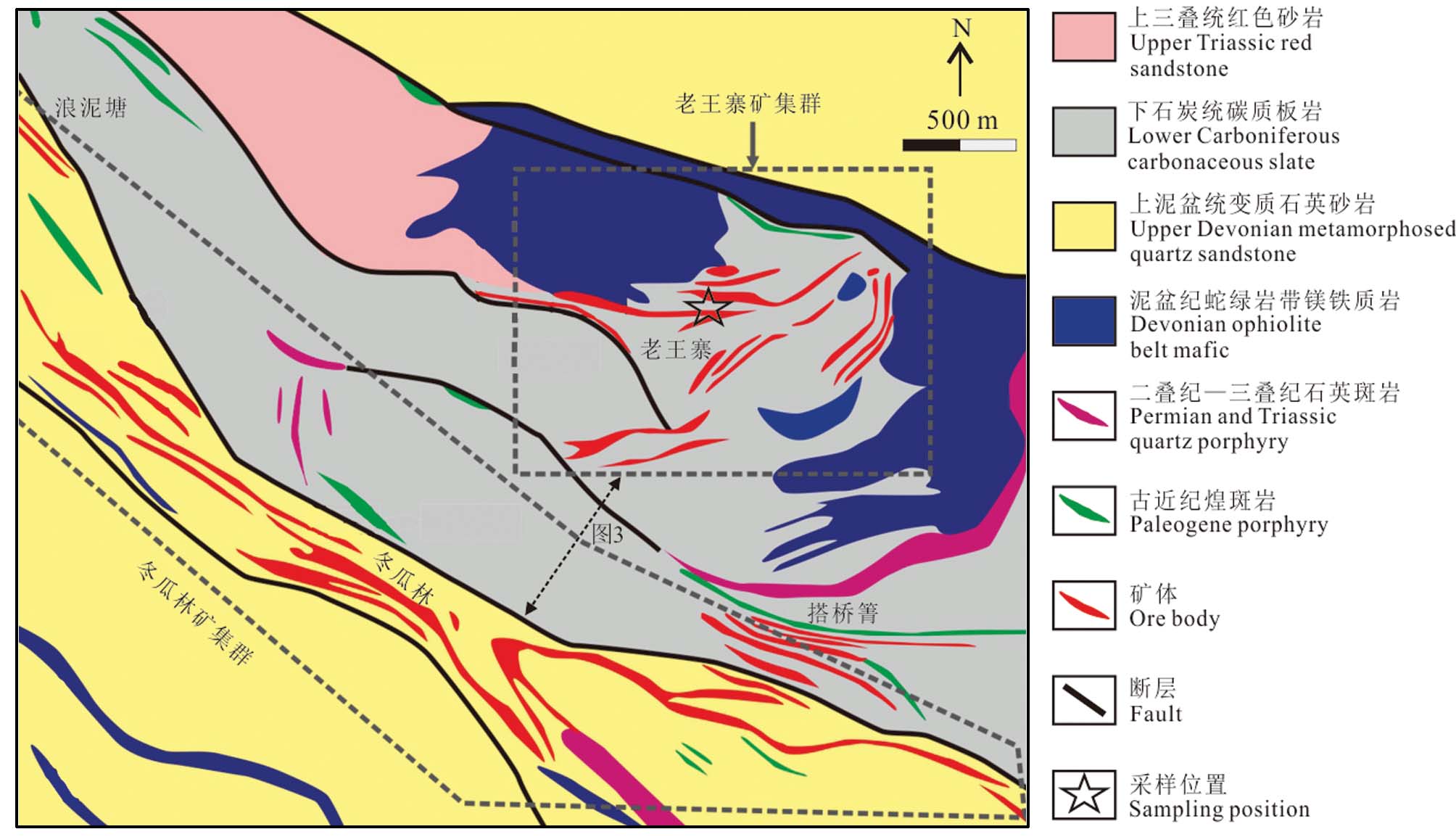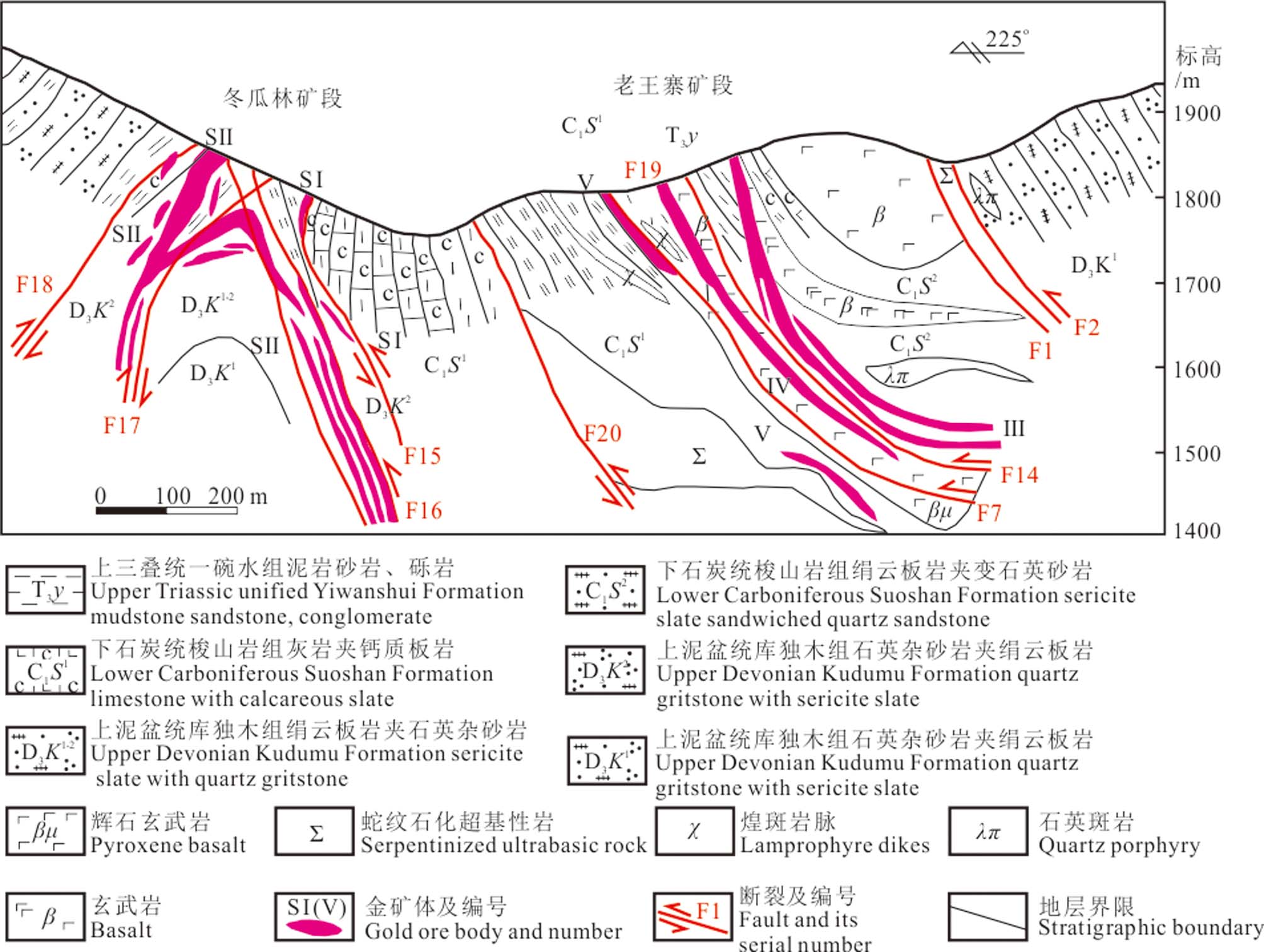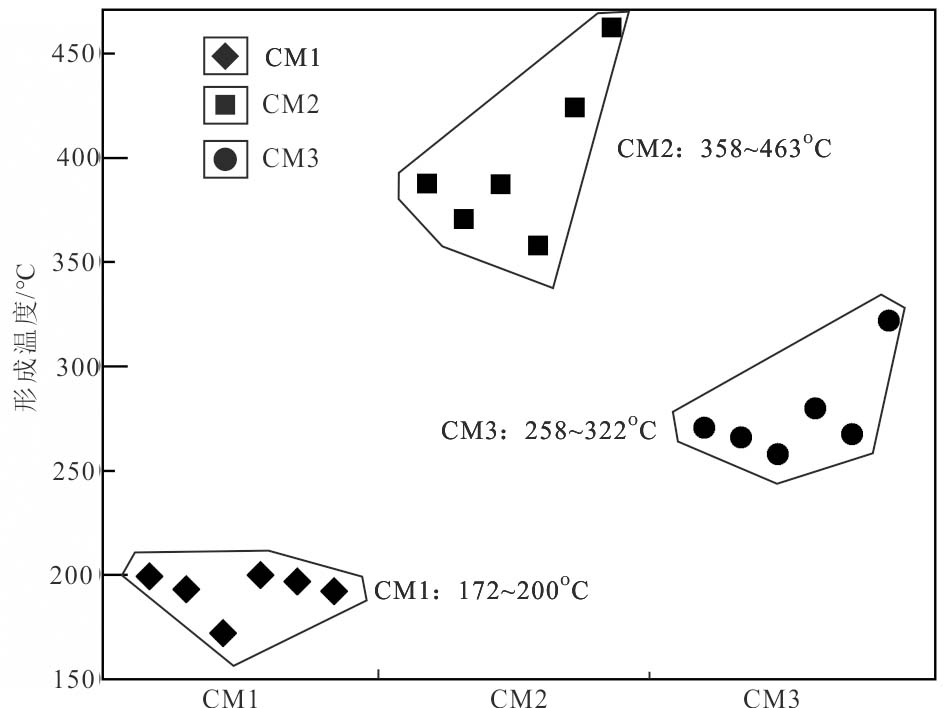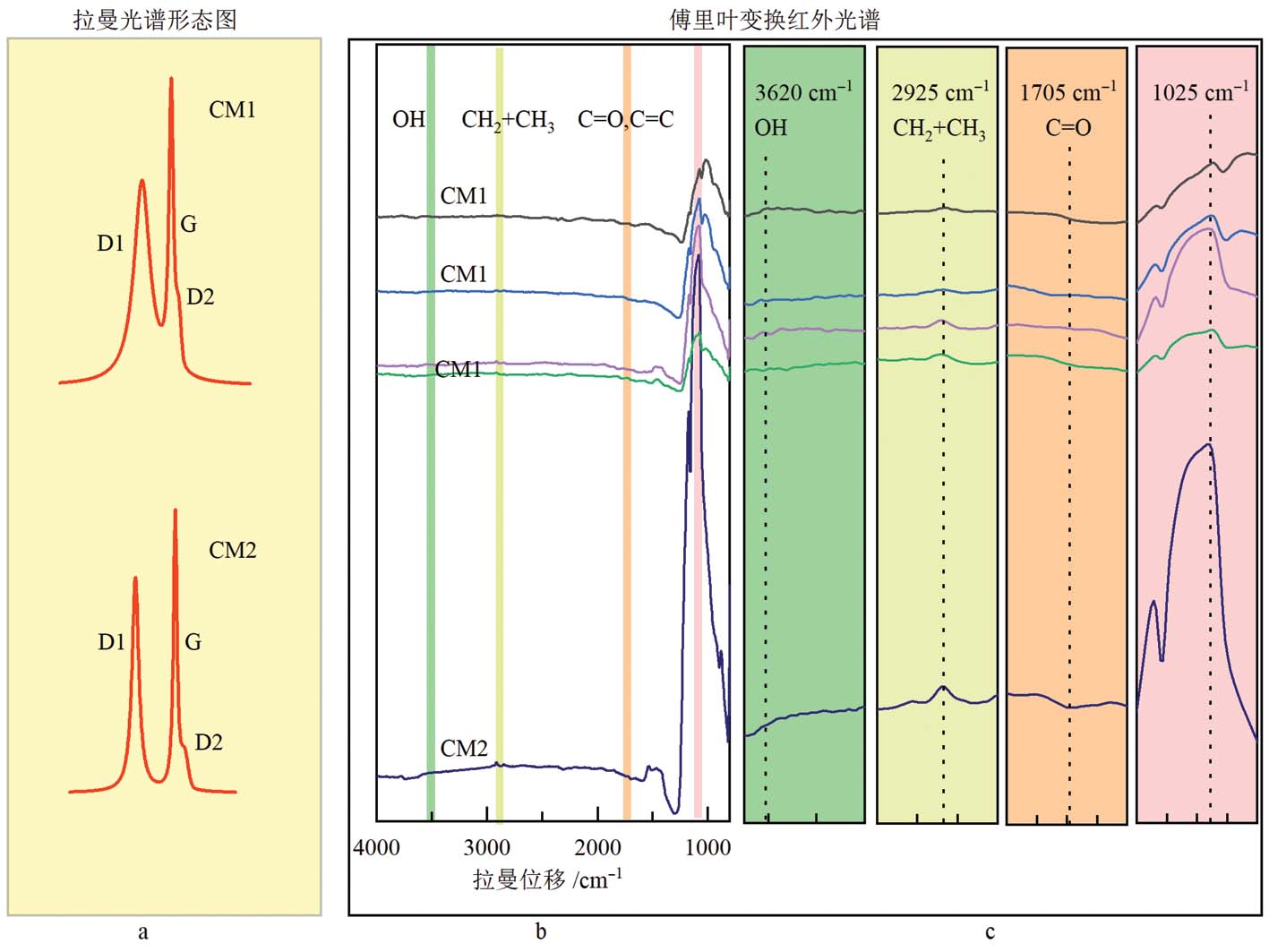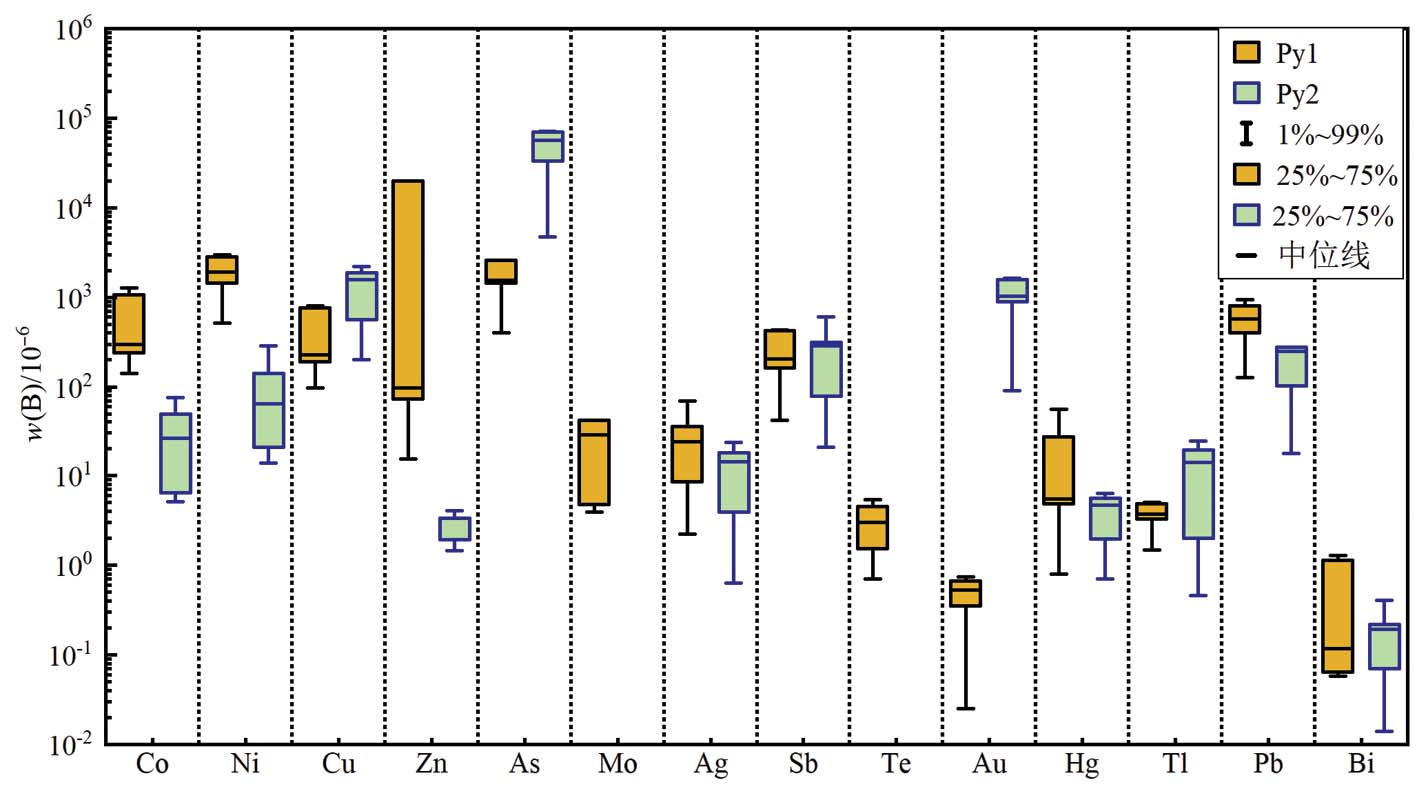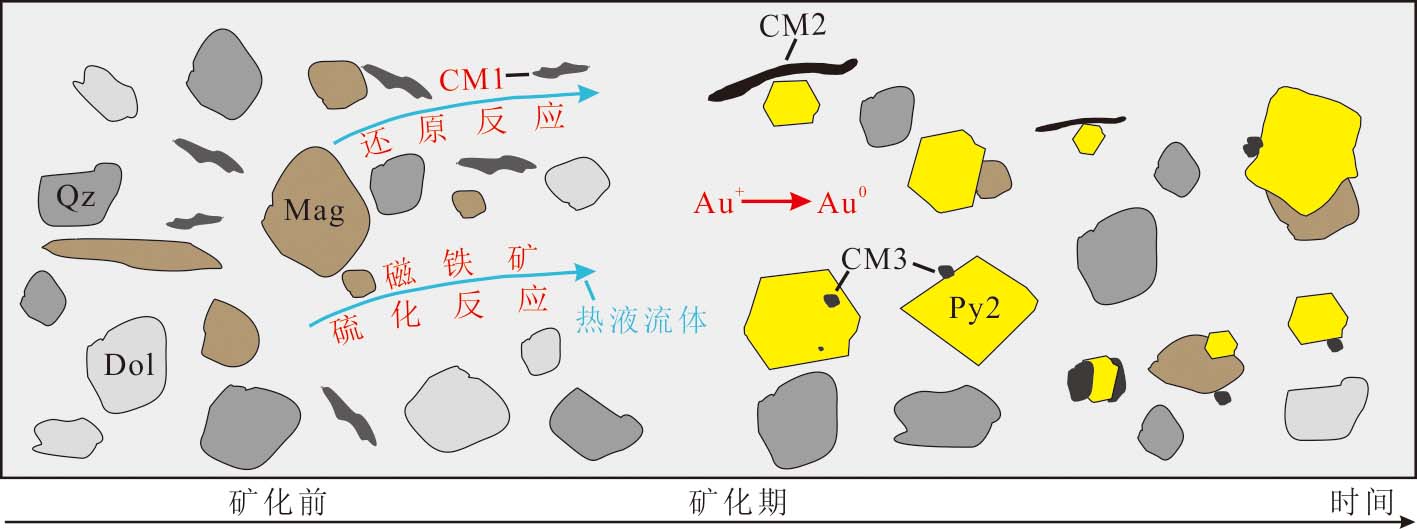-
碳质物(Carbonaceous material,CM)被定义为含有CO/CH键的富碳物质,包括有机物、石墨、沥青和碳氢化合物等(Hu et al., 2015; Mastalerz et al.,1995)。近年来,碳质物被发现存在于许多造山型金矿床中(丁正鹏, 2021; Ding et al., 2023),例如新西兰Macraes矿床(Hu et al., 2015)、澳大利亚Cosmo Howley矿床(Mirasol-Robert et al., 2017)以及中国大桥矿床(Wu et al., 2020)等。然而,碳质物是否在金成矿过程中起到一定的作用还存在争议。一部分观点认为,碳质物对金矿化能够发挥一定的积极作用。例如,在一些造山型金矿床中,碳质物作为还原剂与金的络合物发生氧化还原反应,从而引起金的直接沉淀(Cox et al.,1995; Razvozzhaeva et al., 2008; Steadman et al., 2016)。在这个过程中,碳质物不仅会对金的络合物有直接的吸附作用,而且伴随金沉淀的硫化物也可能会受到碳质物的影响,碳质物会充当硫化物的配体,导致含金成矿流体平衡被破坏,加速了金的沉淀过程(Craw et al., 2008; 2015)。此外,在金矿化之前,地层中的早期低结晶度碳质物有助于促进剪切带的形成,导致剪切带可以汇聚流体并大量富集成矿热液(Craw et al., 2015; Upton et al., 2008)。然而,一些学者认为碳质物在金的沉淀中没有发挥任何作用(Arehart, 1996)。哀牢山金矿带位于三江特提斯造山带的东南部,发育有一系列大型-超大型造山型金矿床(石贵勇等,2012),这些金矿中广泛发育碳质物,前人根据岩相学特征推测镇沅金矿床中碳质物质作为生成物与黄铁矿共同沉淀(李华健,2020),但没有对碳质物的类型、特征、成矿机制进行全面系统的研究。本文以哀牢山金矿带中的镇沅超大型金矿床发现的不同种类的碳质物和共生黄铁矿为研究对象,对其进行了岩相学、拉曼光谱、傅里叶红外光谱、碳同位素和激光剥蚀电感耦合等离子体质谱(LA-ICP-MS)分析,厘定了镇沅金矿中的3种不同类型的碳质物和两期伴生的黄铁矿,分析了碳质物和镇沅金矿成矿事件的关系,研究显示碳质物在镇沅金矿的形成过程中起到重要的作用。
1地质特征1.1区域地质背景哀牢山金矿带位于三江特提斯造山带的东南部,印支地块和华南地块之间(Gao et al., 2018;图1),是一条NW-SE走向呈狭长三角形的长500 km、宽10~50 km的构造带,东部和西部分别以九甲-安定断裂和红河断裂为界(Faure et al., 2016; Wang et al., 2020a;图1)。哀牢山金矿带内部的构造格架由3条北西向断裂控制,从东到西分别为红河断裂、哀牢山断裂和九甲-安定断裂(图1)。红河断裂位于华南板块的西南边界,呈NW-SE走向,倾向北东,宽数百至数千余米。哀牢山断裂呈NW-SE走向,总体倾向北东,局部南西,是元古界哀牢山群高级变质岩和古生代-中生代低级变质岩的分界线。九甲-安定断裂呈NW-AE走向,倾向北东,北端与哀牢山断裂相交,经过九甲、安定地区向南延伸,为哀牢山构造带的西南边界(杨立强等,2010;赵凯,2014)。哀牢山金矿带出露的地层主要有元古界高级变质岩、古生界低级变质岩、中生界未变质或轻度变质碎屑岩和碳酸盐岩(吕聪贵,2014)。古元古界出露地层主要为哀牢山群,哀牢山群为一套混合岩化强烈的深变质岩系,自下而上包括小羊街组、阿龙组、凤港组和乌都坑组,岩石类型主要有黑云斜长片麻岩、黑云片岩、石英片岩、斜长角闪岩和斜长变粒岩等(刘俊来等,2011)。古生界主要分布于哀牢山构造带西侧,哀牢山断裂和九甲-安定断裂之间(于华之,2020),地层主要包括奥陶系、志留系、石炭系和二叠系,为一套碎屑岩、碳酸盐岩和火山岩沉积岩,并且受到区域变质作用,构成了哀牢山低级变质岩带,属绿片岩相(张垚垚,2017)。中生界主要包括三叠系、侏罗系和白垩系。三叠系呈角度不整合与二叠系接触,主要为页岩、灰岩、泥质灰岩、砾岩、砂岩和粉砂岩等,同时含中酸性火山岩。侏罗系以泥岩、粉砂岩、中细粒石英砂岩为主(于华之,2020)。白垩系为一套陆相碎屑岩,含大量的生物化石(张燕,等,2011;张垚垚,2017;辛未,2019)。哀牢山金矿带内出露有大量新元古代岩浆岩,以中酸性岩为主,含有少量镁铁质岩石(辛未,2019)。哀牢山构造带在晚古生代—中生代经历了古特提斯洋演化,在这个过程中产生了一系列基性-酸性岩浆作用(Liu et al., 2012)。始新世—渐新世钾质-超钾质岩浆岩带,沿金沙江-哀牢山构造带延伸(Deng et al., 2014),包括长英质岩石和镁铁质岩石两个系列(Guo et al.,2005;曾普胜等, 2002)。哀牢山金矿带由北到南发育4个重要金矿,分别为镇沅、金厂、大坪和长安金矿床,其中位于哀牢山金矿带北段的镇沅金矿为最大者,其金储量>160 t,平均品位5.3 g/t(杨立强等,2010)。
1.2镇沅金矿矿床地质镇沅金矿床位于云南省镇沅县境内(Wang et al., 2020b;图1),主要由老王寨和冬瓜林2个主要的矿段组成(图2),还有搭桥箐、库独木和浪泥塘等小矿段(杨立强等,2010)。矿区出露的地层有晚古生代、中生代地层。泥盆系库独木组上段下部为灰-深灰色硅质板岩及绢云硅质板岩,中部为灰色-灰黑色薄板状含碳泥质灰岩,上部为浅灰色中厚层状细粒变质石英杂砂岩;石炭系梭山岩组下段为深灰色薄层状泥晶灰岩与灰黑色含碳钙质板岩互层,上部夹绢云砂质板岩,下部夹硅质绢云板岩;石炭系梭山岩组上段上部为灰黑色含碳钙质板岩夹含生物碎屑灰岩,中部为灰黑、浅灰色含碳砂质绢云板岩与变质石英杂砂岩互层,下部为浅灰色硅质绢云板岩、绢云硅质板岩;二叠系那壮岩组为深灰色绢云千枚岩、片状变质石英杂砂岩,夹钙质板岩、硅质板岩、硅质岩;三叠系一碗水组下段为紫红色薄层状凝灰质粉砂岩与紫红、浅灰黄色薄至中厚层状岩屑石英杂砂岩互层(张垚垚,2017)。其中碳质板岩和变质杂砂岩为主要的含矿地层,红色粉砂岩不含矿(李华健,2020;图2)。矿区内广泛发育断裂、褶皱和剪切节理等构造。总体构造以NW为主,走滑断裂在老王寨和冬瓜林矿段均十分发育(张闯等,2012)。矿区岩浆岩比较发育,含有基性超基性岩、酸性斑岩和煌斑岩等(邓碧平等,2014)。金矿体严格被F18、F17到F15脆-韧性剪切带中强应变域控制,金矿体按控矿断裂、容矿地层分SⅠ、SⅡ、SⅢ三个金矿体群。其中赋存于F18、F17到F16断裂带中的金矿体编为SⅡ号金矿体群;赋存在F15断裂带附近的金矿体编号为SⅠ金矿体群;赋存于F16与F15之间的变质杂砂岩构造岩块内的金矿体编号为SⅢ号金矿体群。金矿体在走向和倾向上连续较好,呈脉状,透镜状,条状和层状,沿着层间断裂带产出(图3)。矿石矿物主要是浸染状高砷黄铁矿,含有少量的毒砂。脉石矿物以碳酸盐、绢云母、石英为主(陈英业,2014)。镇沅金矿床可以划分出成矿早期、成矿期和成矿晚期。成矿早期在变质(超)镁铁质围岩中形成石英-方解石-黄铜矿-黝铜矿-黄铁矿-闪锌矿矿物组合;成矿期主要包含有碳酸盐(主要有白云石和铁白云石)-绢云母-黄铁矿-毒砂;成矿晚期主要发育无矿石英-碳酸盐脉,局部见成矿晚期辉锑矿脉穿插石英砂岩和煌斑岩中(高昆丽等,2015)。
图1 哀牢山金矿带简图(据王登红等,2004;李华健等,2019修改)
Fig.1 Schematic diagram of the Ailaoshan gold belt (modified after Wang et al., 2004; Li et al., 2019)
镇沅金矿主要成矿时代主要为喜马拉雅期(黄智龙,1999),其成矿流体具有低盐度和中低温度的特征,流体包裹体的气相成分以H2O为主,其次为CO2;液相成分中,阳离子以Na+和K+为主,Ca2+含量次之;阴离子以SO

和Cl-为主,成矿流体在成分上总体属于Na-Cl型(陈衍景等,2007)。镇沅金矿与典型造山型金矿有诸多相似的特征,例如矿区位置在特提斯喜马拉雅造山带之内;金矿化受次级断裂系统控制;主要的硫化物矿物以黄铁矿、黄铜矿、方铅矿为代表;蚀变包括绢云母化、硅化和绿泥石化;矿化可划分为4个阶段:早期硅化阶段、黄铁矿-绢云母化阶段、黄铁矿-碳酸盐阶段、晚期硅化阶段;成矿流体主要为富CO2、低盐度流体;流体包裹体的均一温度在106~375℃之间;石英的氢氧同位素特征与典型造山型金矿的特征一致;硫化物的铅同位素组成暗示造山构造环境和成矿物质的壳幔混染来源(邓碧平等,2014;边千韬,1998;刘显凡等,2012)。因此,本文将镇沅金矿划分为造山型金矿。
图2 镇沅金矿床冬瓜林和老王寨矿段地质图(据李华健等,2019修改)
Fig.2 Geological map of the Donggualin and Laowangzhai ore clusters of the Zhenyuan gold deposit (modified after Li et al., 2019)
2样品和研究方法2.1样品描述和岩相学观察本次研究所用样品采自老王寨矿段(图2),样品编号LWZ007,样品为夹有含金石英脉的碳质板岩(图4);碳质板岩大规模出露在老王寨和冬瓜林矿段,发育广泛的热液蚀变并形成矿体,是镇沅金矿主要的赋矿岩性(图2);碳质板岩中发育的蚀变矿物组合有:碳酸盐(白云石和铁白云石),绢云母,黄铁矿以及少量的毒砂;其中金主要以不可见金的形式赋存在热液含砷黄铁矿中。
选取夹有含金石英脉的碳质板岩标本共12件,制成薄片24件,进行详细的光学显微镜下观察。光学显微镜下观察在中山大学海洋科学学院实验室进行,仪器型号为德国ZEISS AXIO偏反两用显微镜。
2.2测试方法(1)拉曼光谱分析
拉曼光谱实验在中山大学海洋资源与近岸工程重点实验室完成,采用的是英国雷尼绍公司生产的inVia Reflex共焦激光拉曼光谱仪。激光分析设置为5 mW的输出激光功率、宽度约1μm的激光束、分析时间20 s,100~3500 cm-1的光谱范围,覆盖了CM的所有峰。为减小误差,每个CM测量6次。拉曼特征(峰面积和峰强度)使用PeakFit 4.12程序计算。
碳质物特有的拉曼光谱形态特征与碳质物所经历的最高温度关系密切。经历的温度越高,其碳原子排列结构则越有序,碳质物特征峰(G峰)的强度会相对增加,而特征峰宽度会变窄。碳质物本身晶格缺陷所形成的缺陷峰(D峰)强度会相对降低,由于物理化学作用对于碳原子有序结晶成单质碳晶体是一种不可逆转变过程。在区域变质作用中,温度往往对于地层中的碳质物存在最直接影响,碳质物基本能够记录其区域变质作用的温度,并通过D峰和G峰等碳质物特征峰的相对面积反演碳质物可能经历的最高温度,这是由碳本身特殊的物理性质所决定的。根据以上原理,前人通过D峰和G峰的相对面积比和高度比R1和R2来定量化不同碳质物拉曼光谱所展现的拉曼光谱特征,其计算方式如下(Rahl et al., 2005):
图3 老王寨和冬瓜林矿段剖面图(据张闯等,2012)
Fig.3 Section of Laowangzhai and Donggualin mine section (after Zhang et al., 2012)
(1)
(2)
Rahl(2005)等人通过推导R1和R2与变质温度之间的二次相关关系,反演出一种碳质物温度计算公式(Rahl et al.,2005),置信度大于90%:
(3)
(2)傅里叶变换红外光谱
在中山大学测试中心进行了傅里叶变换红外光谱实验,所用仪器型号NICOLET6700,生产厂家是美国Thermo Scientific公司。红外光谱仪主机技术指标光谱范围为8000~350 cm-1,分辨率:0.15 cm-1,信噪比高于50000∶1(1 min测试,测试条件:DTGS检测器,4 cm-1分辨率,谱区范围2200~2100 cm-1)。红外显微成像技术指标:焦平面阵列检测器,信噪比7000∶1,自动面扫描台,焦平面阵列检测器光谱范围,空间分辨:4000~900 cm-1,空间分辨:1.1 μm,自动面扫描空间精度:0.1 μm。
(3)碳同位素质谱仪分析
碳同位素的测定和分析在中山大学海洋科学学院海洋沉积物地球化学实验室完成。首先将样品用玛瑙研钵研磨至300目左右,称取研磨后的粉末样品2 g置于干净烧杯中,加入浓度为10%的稀盐酸,用玻璃棒搅拌使其充分反应,加玻璃盖放通风橱中静置,期间每隔2 h对样品进行搅拌。48 h之后将烧杯中的溶液移至离心管内进行洗涤、离心,倾倒上层清夜,重复此过程,直至试管中的样品pH为7左右,将洗至中性的样品倒入烧杯然后用45℃烘箱烘干,最后称取烘干后的样品4 mg,用锡舟包好进行上机测试。所用仪器为IRMS同位素比质谱仪(MAT 253 Plus),标样IAEA-600被用来对系统进行准确度和精密度的监测,测量精度为±0.2‰,δ13C数据均为VPDB标准。
(4)LA-ICP-MS微量元素分析
LA-ICP-MS微量元素分析在拓岩测试技术有限公司利用COMPexPro 102ArF准分子激光(波长193 nm,最大能量200 mJ)和MicroLas光学系统完成。GeolasPro激光烧蚀系统测量了11种微量元素的组成(59Co、60Ni、65Cu、66Zn、75As、97Mo、107Ag、121Sb、 126Te、197Au、202Hg、205Tl、208Pb、209Bi)。载气为氦气(480 mL/min),补气为氩气(900 mL/min)。激光光斑大小和频率分别设置为24 μm和5 Hz。内标采用铁(57Fe),外标采用MASS-1合成黄铁矿和NIST610。采用基于Excel的ICPMSDataCal进行数据处理,包括背景/分析信号的离线选择和整合、时间漂移校正和微量元素校准(Liu et al., 2008)。
3测试结果3.1岩相学特征标本中碳质板岩与含金石英脉互层,硫化物在碳质板岩和石英的边界分布(图4a),矿物组合相对比较简单:在碳质板岩中识别出草莓状黄铁矿,并伴生大量磁铁矿,金红石沿黄铁矿边界及裂隙交代黄铁矿,呈交代溶蚀结构(图4b)。在含金石英脉中,黄铁矿为自形(图4c、d),可见黄铁矿交代早期磁铁矿,呈交代结构(图4f)。
详细的光学显微镜观察到3种不同的CM(CM1~CM3,图4c~d)。其中,CM1广泛存在于赋矿围岩碳质板岩中,镜下CM1呈深灰色、不规则形态,粒径变化较大,在1~80 μm不等,具明显棱角,磨圆度较差,与草莓状黄铁矿Py1共生(图4b)。CM2和CM3赋存于碳质板岩的夹层含金石英脉中,镜下CM2呈黑色细长沥青状,分布在细粒自形黄铁矿Py2周围(图4c)。镜下CM3呈灰色细小颗粒状,粒径1~10 μm,棱角不明显,磨圆度较好,周围分布大量的自形黄铁矿Py2,Py2与CM3空间关系密切,Py2是基本沿着CM3分布或者与CM3一起生长(图4d、e)。
3.2拉曼光谱特征表1展示了CM1、CM2和CM3各6组的光谱数据和形成温度。图5为此3种类型碳质物的拉曼光谱图,其中,CM的拉曼光谱有2个明显的特征峰,分别是无序峰(D1峰)和有序峰(G峰),此外还有一个峰值不明显的D2峰,是由双震动拉曼散射形成的。CM1的光谱特征是在大约1322.8 cm−1处具有低强度、宽的D1带,而在1592.8 cm−1处具有高强度、窄的G峰,D2峰较明显,表明CM1结构具有无序性(图5a)。相比于CM1,CM2的D1和G峰更为尖锐,面积近似,D2峰的光谱分峰程度很低,说明CM2的结构有序性比较强,CM2的D1峰位置约为1341.7 cm−1,G峰位置为1581.2 cm−1(图5b)。CM3的拉曼光谱特征与CM1的拉曼光谱相似,但CM3的D2峰具有独立的峰段,CM3的D1峰位置约为1332.7 cm−1,G峰位置为1600.7 cm-1(图5c)。
基于以上结果,我们利用上文的公式(3)分别对CM1、CM2和CM3进行变质温度计算,计算结果显示CM1的温度范围是172~200°C(平均193°C),低于该矿成矿温度(250~330°C,杜达洋,2015);CM2的温度范围是358~463°C(平均399°C),高于成矿温度;CM3的温度范围是258~322°C(平均278°C),与成矿温度基本一致(图6)。
3.3傅里叶特征需要说明的是由于CM3粒径较小,实验实施比较困难,所以并未对其进行傅里叶变换红外光谱实验,只对CM1和CM2进行了傅里叶变换红外光谱实验。红外光谱分析显示(图7),CM1和CM2的CH的伸缩振动吸收峰出现在2700~3000 cm−1范围内,OH分子的伸缩振动产生了3620 cm−1和3400 cm-1谱线,与对称和不对称CH2和CH3相关的谱线位于2925 cm−1和2865 cm−1,170 5cm−1和1630cm−1处的谱峰分别与C=O和C=C键相关,碳峰范围在1025~1035 cm−1。如图7所示,CM1和CM2的红外光谱差别较大,CM1石墨化程度低,含有较少的CH键和C=O键;CM2石墨化程度高,在2925 cm−1和1705 cm−1处有明显的谱峰,含有较多的CH2、CH3、C=O和C=C键。
图4 镇沅金矿中夹含金石英脉的碳质板岩手标本及显微照片 a. 碳质板岩与石英脉互层;b. 分布在碳质板岩中的CM1镜下特征;c. 分布在石英脉中的CM2镜下特征;d、e.分布在石英脉中的CM3镜下特征;f. 石英脉中黄铁矿交代早期磁铁矿显微照片 Qz—石英;Py—黄铁矿;Mag—磁铁矿;Rt—金红石;CM—碳质物
Fig.4 Hand specimen and micrograph of carbonaceous slate containing gold-bearing quartz veins in Zhenyuan gold deposit. a. Carbonaceous slate interbedded with quartz veins; b. CM1 distributed in carbonaceous slate; c. CM2 distributed in quartz veins; d, e. CM3 distributed in quartz veins; f. Micrograph of the replacement of earlier magnetite by pyrite in quartz vein Qz—Quartz; Py—Pyrite; Mag—Magnetite; Rt— Rutile; CM—Carbonaceous material
3.4碳同位素组成因技术手段及客观原因的限制,我们在对CM2样品的提取过程中发现其提取量有限,远远小于CM1和CM3的含量,无法获得足量CM2用于碳同位素分析。因此本次用微区取样仪主要对CM1和CM3进行提取和碳同位素组成分析。二者碳同位素测试结果如表2所示,碳质板岩中CM1的δ13C范围-26.46‰~-26.89‰,平均-26.66‰,含金石英脉CM3的δ13C范围-9.09‰~-14.12‰,平均-10.96‰,二者相差相当显著。
表1 CM1、CM2和CM3的光谱数据和形成温度
Table1 Spectral data and formation temperatures for CM1, CM2 and CM3
对比项
D1峰值/cm-1
D1峰面积/cm-1
G峰值/cm-1
G峰面积/cm-1
D2峰值/cm-1
D2峰面积/cm-1
R1
R2
T/°C
CM1
15500
3240000
18100
1280000
1630
66600
0.86
0.71
200
2270
625000
2060
200000
338
8830
1.10
0.75
193
23400
7090000
32600
2570000
4720
372000
0.72
0.71
172
36600
7250000
52900
3310000
5040
174000
0.69
0.68
200
41500
10700000
49800
4180000
5640
307000
0.83
0.70
197
5750
1830000
3910
467000
609
19000
1.47
0.79
193
CM2
840
85000
4160
126000
341
10300
0.20
0.39
388
23400
1760000
30200
1400000
3030
149000
0.78
0.53
371
1610
139000
6560
195000
564
16700
0.24
0.40
388
29300
2120000
37500
1340000
4010
433000
0.78
0.54
358
27400
1660000
42600
1780000
4800
201000
0.64
0.46
424
1790
106000
6810
193000
698
19850
0.26
0.33
463
CM3
20200
3270000
23200
1690000
3410
131000
0.87
0.64
271
8760
1670000
8890
717000
1970
123000
0.99
0.66
266
8790
1870000
7250
573000
2730
216000
1.21
0.70
258
17500
3150000
23100
1940000
2040
44800
0.76
0.61
280
17500
2950000
22900
1690000
1960
74900
0.76
0.63
268
2750
319000
4120
251000
150
3680
0.67
0.56
322
图5 CM1(a)、CM2(b)和CM3(c)的激光拉曼光谱图
Fig.5 Laser Raman spectra of CM1 (a), CM2 (b) and CM3 (c)
3.5黄铁矿LA-ICP-MS分析微量元素组成表3中列出了Py1和Py2的LA-ICP-MS黄铁矿微量元素分析数据,它们各自的元素含量箱型图如图8所示。
Py1各元素含量中位值w(Co)为296×10-6,w(Ni)为1909×10-6,w(Cu)为229×10-6,w(Zn)为96.8×10-6,w(As)为1545×10-6,w(Mo)为28.7×10-6,w(Ag)为24.1×10-6,w(Sb)为204×10-6,w(Te)为3.01×10-6,w(Au)为0.53×10-6,w(Hg)为5.54×10-6,w(Ti)为3.76×10-6,w(Pb)为576×10-6,w(Bi)为0.12×10-6;Py2各元素含量中位值w(Co)为26.1×10-6,w(Ni)为64.7×10-6,w(Cu)为1578×10-6,w(Zn)为1.94×10-6,w(As)为56325×10-6,w(Ag)为14.2×10-6,w(Sb)为289×10-6,w(Au)为1028×10-6,w(Hg)为4.69×10-6,w(Ti)为14.2×10-6,w(Pb)为247×10-6,w(Bi)为0.19×10-6(图8)。Py1的Co,Ni,Zn含量高于Py2;Py2的As,Au含量高于Py1。Py2中没有检测到Mo和Te元素。
4讨论4.1两类黄铁矿成因根据显微照片观察和LA-ICP-MS分析结果,本研究中识别出两种不同类型黄铁矿Py1和Py2。其中,草莓状黄铁矿Py1赋存于碳质板岩中并分布广泛,而自形颗粒状Py2则主要分布于碳质板岩的夹层含金石英脉中。LA-ICP-MS结果表明,Py1和Py2具有完全不同的微量元素特征,Py1中通常富集更多的Co,Ni和Cu等元素,相对匮乏Au和As。在前人的研究中,海水中通常存在大量的Co,Ni,Cu等金属元素,因此在早期形成沉积成因的黄铁矿早期通常能够从海水中吸附这类金属并富集(Majumdar et al., 2020)。因此,我们推断Py1更可能形成于成岩期,属于沉积成因的黄铁矿。根据前人李华健(2020)的研究成果,镇沅金矿碳质板岩中草莓状黄铁矿的硫同位素值变化较大(-54.58‰~38.31‰),也证明了其属于碳质板岩成岩过程中的产物。
图6 CM1、CM2和CM3的形成温度对比图
Fig.6 Comparison chart of formation temperature of CM1, CM2 and CM3
表2 CM样品的碳同位素值(‰)
Table 2 δ13C(‰) of CM samples(‰)
样品类型
δ13C/‰
碳质板岩(CM1)
-26.66
-26.64
-26.65
-26.46
-26.65
-26.89
含金石英脉(CM3)
-10.06
-10.86
-10.61
-11.00
-9.09
-14.12
图7 CM1和CM2的拉曼光谱形态图(a)和傅里叶变换红外光谱(FTIR)结果(b)比较,(c)为(b)的局部放大图
Fig.7 Comparison of Raman spectral results (a) and FTIR results (b) of CM1 and CM2, (c) is the local amplification of (b)
表3 Py1和Py2的微量元素分析结果
Table3 Trace element analysis data for Py1 and Py2
编号
w(B)/10-6
Co
Ni
Cu
Zn
As
Mo
Ag
Sb
Te
Au
Hg
Tl
Pb
Bi
Py1-1
1265
2980
806
19775
2575
40.4
35.7
422
3.65
0.53
27.1
4.16
799
1.28
Py1-2
1071
2822
762
117218
2569
42.3
29.1
429
2.38
0.35
56.2
4.84
942
1.13
Py1-3
141
514
97.8
73.4
402
17.0
2.23
42.5
—
0.03
0.80
1.49
126
0.07
Py1-4
239
1448
264
77.2
1499
42.1
19.1
212
—
0.67
4.91
3.36
465
0.17
Py1-5
249
1984
191
15.5
1591
3.90
8.66
164
—
—
6.18
3.31
399
0.06
Py1-6
341
1833
193
116
1447
4.77
69.8
195
0.71
0.74
4.85
5.06
686
0.06
Py2-1
49.5
286
200
4.07
4717
—
0.63
20.8
—
90.2
0.70
0.46
17.8
0.01
Py2-2
5.09
13.9
1879
—
69699
—
23.5
600
—
890
6.31
24.4
571
0.40
Py2-3
12.9
20.8
1777
3.36
65899
—
18.1
304
—
1023
5.20
16.3
279
0.21
Py2-4
76.6
142
2199
1.45
71779
—
18.2
315
—
1033
5.64
19.4
252
0.17
Py2-5
6.43
42.6
568
1.94
33511
—
3.96
79.4
—
1621
1.98
2.00
102
0.07
Py2-6
39.4
86.9
1378
1.94
46750
—
10.3
273
—
1583
4.18
12.2
243
0.22
注:“—”表示低于检测限。
图8 Py1和Py2微量元素含量箱型图
Fig.8 Box and whisker plots of Py1 and Py2 trace elements contents
与Py1不同,Py2较匮乏Co,Ni,Cu等元素,而明显富集Au和As。Py2作为石英脉中最主要的含金矿物可以通过两种过程(固态扩散(SSD)和耦合溶解-沉淀(CDR))形成(Adegoke et al., 2022)。在含金石英脉矿石中,我们未发现Py1的存在和Py2遭受早期改造的痕迹,同时,Py1很难提供Py2中所富集的大量Au和As,此外,Py2也未继承Py1的元素特征,因此,Py2不可能是由Py1转变而来,暗示Py2属于后期热液产物。李华健(2020)研究表明,镇沅金矿中自形黄铁矿的硫同位素值范围较窄(-4.95‰~4.16‰,平均0.02‰),与Py1的范围差距较大,指示Py2来源于成矿热液中。因此,我们推断在含金石英脉形成过程中由于构造作用、流体混合和水岩反应等导致热液流体的温度、压力、pH、硫逸度等物化性质发生改变,使得Au和As取代了Py2部分晶格中的Fe共同沉淀,形成了富Au、As的Py2。
4.2碳质物的成因前人研究表明CM存在多种成因:通过变质条件形成(Bierlein et al., 2001; Berge, 2011)或来自有机碎屑(Luque et al.,1998; Jehlička et al., 2003)。最初存在于岩石中的有机质逐渐经历变质转变,失去氢、氮和氧,从而含有更多富碳成分(Kribek et al.,1994; Jehlička et al.,2003),这一过程被称为石墨化,其中有序性差的低温生物前体经历结构、显微组织和化学组成的改变,并最终随着变质程度的增加转变为高度结晶的石墨(Wopenka et al., 1993; Large et al., 1994; Beyssac et al., 2002)。而Pitcairn等人(2005)对新西兰Otago地区的CM使用傅里叶变换红外光谱技术分析表明,矿石中部分CM是从热液流体中沉淀出来的,即CM也可以从富碳、甲烷的热液流体中沉积(Craw, 2002; Pitcairn et al., 2005; Luque et al., 2009; Kříbek et al., 2015)。
在本研究中,CM1广泛分布于镇沅金矿的碳质板岩中,没有热液改造的痕迹,并且和Py1共生,未见共生的其他类型黄铁矿(图4b)。CM1的拉曼光谱和含有较少CH键和C=O键的傅里叶红外光谱特征表明其成熟度低和结晶度差(图5、图7)。CM1的形成温度计算结果(图5)表明其形成温度低,为172~200°C,低于成矿温度,与其光谱特征一致;此外CM1样品的δ13C在-26.46‰到-26.89‰之间,证明CM1来源于有机质,属于变质成因。同时,因碳质物形成温度随着变质程度的增加而增加(Beyssac et al., 2004; Lahfid et al., 2010),故镇沅金矿中CM1较低的形成温度显示其经历的变质作用较弱,变质程度比较低。
CM1的形成过程如图9所示。由于大气中氧突然增加,使富含金属的大陆岩石中硫化物矿物氧化风化,导致硫酸盐浓度增加,并由河流带入海洋(Canfield, 1998; Johnson, 2017; Absar et al., 2016)。陆地不断向含氧表层水提供营养物质,导致海水透光层有机生产力水平的提高。有机物作为还原剂,会将溶解在海水中的大量硫酸盐离子还原为H2S(Berner, 1984)。在缺氧的沉积环境中,有机质积累和还原的速度高,导致底层水体和海底沉积物中H2S的富集(Berner, 1984)。随着有机质的不断生成和氧化还原反应的持续发生,各种金属以及氧化还原敏感的微量元素会向缺氧海水下的沉积物运输和积累。这些微量元素还原后会吸附到有机质沉积物上(图9a)。随后富含有机质的沉积物经历早期成岩作用形成泥岩或者黑色页岩(图9b)。在经历进一步的区域变质作用后,岩石变质为碳质板岩,部分有机质演化为CM1(图9c)。
CM2分布于碳质板岩的夹层含金石英脉中(图4c),CM2的拉曼光谱和含有较多CH键、C=O和C=C键的傅里叶红外光谱特征表明其成熟度高和结晶度好(图5、图7)。拉曼温度计算结果(图6)显示,CM2的形成温度为358~463°C,而成矿温度为250~330°C;同时,拉曼光谱温度计记录的是碳质物在地质历史上经历的最高温度,并且只会记录形成过程中所经历的最高温度,不会受到后期的低温作用影响。在本文实验结果中,CM2的形成温度范围显然已经超过了正常的成矿期流体温度,因此我们推测CM2也为变质成因。
CM3广泛分布于碳质板岩的夹层含金石英脉中,与Py2共生;热液期黄铁矿Py2交代了早期形成的磁铁矿并且CM3呈颗粒状与Py2共同沉淀(图4d、f),说明CM3与矿化密切相关。同时,我们未发现只分布在含金石英脉中的CM3遭受热液改造的痕迹,并且拉曼温度计算结果(图6)表明CM3的形成温度为258~322°C,与成矿温度一致。另外,CM3样品的δ13C值为-9.09‰~-14.12‰。以上证据表明,CM3与CM1和CM2不同,不属于沉积作用的产物,而应该为热液成因。
CM3中的碳最早来源于成矿流体,当成矿流体在高温高压条件下由深部向浅部运移的过程中,由于温度和压力的急剧变化,导致其无法维持稳定的状态,从而造成氧逸度和硫逸度的升高并释放O2和H2S。此后,成矿流体在迁移过程中会与围岩碳质板岩中早期形成的磁铁矿(图4b)发生硫化反应,导致CM3和Py2的共同沉淀(图10)。其中,围岩中大量的磁铁矿提供硫化反应中的铁,热液流体提供硫化氢和二氧化碳。反应为:
(4)
硫化作用是溶液中的还原硫沉淀成黄铁矿的有效方式。另外,这种与热液作用相关的CM3通常会立即形成,而变质作用产生的CM1要经过数百万年才形成(Craw et al., 2015)。
4.3碳质物在金成矿过程中的作用本文研究中,CM1广泛存在于赋矿围岩碳质板岩中,与其共生的成岩期黄铁矿Py1金浓度为0.5×10-6;CM2和CM3赋存于碳质板岩的夹层含金石英脉中,与CM3共生的热液期黄铁矿Py2金浓度为1028×10-6,且硫化物多分布在碳质板岩和含金石英脉的边界上(图4a)。另外,前人研究表明,镇沅金矿中金的络合物主要与HS-离子进行配位(AuHS0和Au(HS)
 )运移(李华健,2020)。根据以上讨论,我们认为CM1形成于成矿前的变质作用,具有强还原性和吸附性,因此当成矿流体涌入时,成矿流体会与碳质板岩中广泛存在的CM1大面积接触并发生水岩反应,CM1能够大量还原成矿流体中的AuHS0和Au(HS)
)运移(李华健,2020)。根据以上讨论,我们认为CM1形成于成矿前的变质作用,具有强还原性和吸附性,因此当成矿流体涌入时,成矿流体会与碳质板岩中广泛存在的CM1大面积接触并发生水岩反应,CM1能够大量还原成矿流体中的AuHS0和Au(HS) ,导致金的沉淀(图10)。水岩反应的过程可表示为:
,导致金的沉淀(图10)。水岩反应的过程可表示为:
图9 镇沅金矿碳质板岩中CM1的形成模型图(据Subhashree,2020修改)。 a.海底沉积物的形成和微量元素的还原、吸附;b.在沉积和早期成岩作用期间形成的泥岩/黑色页岩;c.钴、镍、铜、锌、砷、钼、银、锑、金、汞、钛、铅等微量元素从有机质中释放到生长的沉积黄铁矿的晶格中
Fig. 9 Formation model of CM1 in carbonaceous slate of Zhenyuan gold deposit (modified after Subhashree et al., 2020) a. Formation of the seafloor sediments and reduction, adsorption of trace elements; b. Mudrock/Black shale formed during sedimentation and early diagenesis; c. Trace elements such as Co, Ni, Cu, Zn, As, Mo, Ag, Sb, Au, Hg, Ti, Pb, etc., get partitioned into the lattice of growing sedimentary pyrites from the organic matter
(5)
(6)
这也是硫化物多分布在碳质板岩和含金石英脉边界上的原因。
成矿流体在运移的过程中会与碳质板岩中的磁铁矿发生硫化反应,导致CM3沉淀。如方程式(4)所示,这种热液成因的CM3,其有利于硫化物的沉淀,促进硫化作用的发生,同时会降低热液流体中H2S浓度,进一步破坏金硫化物络合物的稳定性,导致金的沉淀(图10)。
5结论(1)镇沅金矿碳质板岩及其所夹含金石英脉中可见3种碳质物:CM1、CM2和CM3。CM1来源于有机质,经历变质作用后形成于碳质板岩的早期成岩阶段,属于变质成因;CM2的温度高于成矿温度,也为变质成因;而CM3来源于成矿流体,是由于围岩中的含铁矿物和成矿流体发生硫化反应导致其从流体中沉淀,属于热液成因。
(2)与CM1共生的草莓状黄铁矿Py1形成于成岩期,属于沉积期黄铁矿,含有少量金;而与CM3共生的自形黄铁矿Py2为热液产物,通过含铁矿物与热液流体发生硫化作用而沉淀,含金量比较高。
图10 CM3和Py2的形成及成矿过程示意图 Dol—白云石;Qz—石英;Mag—磁铁矿;Py—黄铁矿;CM—碳质物
Fig.10 Schematic diagram of the formation of CM3 and Py2 and mineralization process Dol—Dolomite; Qz—Quartz; Mag—Magnetite; Py—Pyrite; CM—Carbonaceous material
(3)CM1和CM3在镇沅金矿的形成过程中起到重要的作用。CM1作为还原剂能够有效地和金的硫氢络合物反应从而促使金的沉淀。CM3在硫化过程中和Py2共同沉淀导致成矿流体中H2S的大量消耗,进一步破坏金的硫氢络合物稳定性导致金的沉淀和再富集。
致 谢本论文研究过程中测试分析和数据处理中得到中山大学博士后刘巧芬和佟子达、博士生李政坤、苗烽钰、刘莹和硕士生黄菲,以及西北大学焦少通等帮助,谨致谢忱!
-
参考文献
Absar N, Nizamudheen B M, Augustine S, Managave S and Balakrishnan S. 2016. C, O, Sr and Nd isotope systematics of carbonates of Papaghni sub-basin, Andhra Pradesh, India: Implications for genesis of carbonate-hosted stratiform uranium mineralisation and geodynamic evolution of the Cuddapah basin[J]. Lithos, 263: 88-100.
Adegoke I A, Xia F, Deditius A P, Pearce M A, Roberts M P and Brugger J. 2022. A new mode of mineral replacement reactions involving the synergy between fluid-induced solid-state diffusion and dissolution-reprecipitation: A case study of the replacement of bornite by copper sulfides[J]. Geochimica et Cosmochimica Acta, 330: 165-190.
Arehart G B. 1996. Characteristics and origin of sediment-hosted disseminated gold deposits: A review[J]. Ore Geology Reviews, 11(6): 383-403.
Berge J. 2011. Paleoproterozoic, turbidite-hosted, gold deposits of the Ashanti gold belt (Ghana, west Africa): Comparative analysis of turbidite-hosted gold deposits and an updated genetic model[J]. Ore Geology Reviews, 39(1-2): 91-100.
Berner R A. 1984. Sedimentary pyrite formation: An update[J]. Geochimica et Cosmochimica Acta, 48(4): 605-615.
Beyssac O, Bollinger L, Avouac J and Goffé B. 2004. Thermal metamorphism in the lesser Himalaya of Nepal determined from Raman spectroscopy of carbonaceous material[J]. Earth and Planetary Science Letters, 225(1-2): 233-241.
Beyssac O, Rouzaud J, Goffe B, Brunet F and Chopin C. 2002. Graphitization in a high-pressure, low-temperature metamorphic gradient: A Raman microspectroscopy and HRTEM study[J]. Contributions to Mineralogy and Petrology, 143(1): 19-31.
Bian Q T. 1998. Exploration on the relationship between crust mantle structure and formation of Laowangzhai super-large gold deposit[J]. Science in China (Earth Sciences), 28(4): 303-309(in Chinese with English abstract).
Bierlein F P and Maher S. 2001. Orogenic disseminated gold in Phanerozoic fold belts: Examples from Victoria, Australia and elsewhere[J]. Ore Geology Reviews, 18(1-2): 113-148.
Canfield D E. 1998. A new model for Proterozoic ocean chemistry[J]. Nature, 396(6710): 450-453.
Ceng P S, Mo X X and Yu X H. 2002. Nd, Sr and Pb isotopic characteristics of the alkaline-rich porphyries in western Yunnan and its compression strike-slip setting[J]. Acta Petrologica et Mineralogica, 21(3): 231-241(in Chinese with English abstract).
Chen Y J, Ni P, Fan H R, Pirajno F, Lai Y, Su W C and Zhang H. 2014. Diagnostic fluid inclusions of different types hydrothermal gold deposits[J]. Acta Petrologica Sinica, 23(9): 2085-2108(in Chinese with English abstract).
Chen Y Y. 2014. The geological feature of Laowangzhai Au deposit, Zhenyuan[J]. Yunnan Geology, 33(3): 367-370(in Chinese with English abstract).
Cox S F, Sun S S, Etheridge M A, Wall V J and Potter T F. 1995. Structural and geochemical controls on the development of turbidite-hosted gold quartz vein deposits, Wattle Gully Mine, central Victoria, Australia[J]. Econ. Geol., 90: 1722-1746.
Craw D. 2002. Geochemistry of late metamorphic hydrothermal alteration and graphitisation of host rock, Macraes gold mine, Otago Schist, New Zealand[J]. Chemical Geology, 191(4): 257-275.
Craw D, Burridge C P, Upton P, Rowe D L and Waters J. 2008. Evolution of biological dispersal corridors through a tectonically active mountain range in New Zealand[J]. Journal of Biogeography, 35: 1790-1802.
Craw D, MacKenzie D and Grieve P. 2015. Supergene gold mobility in orogenic gold deposits, Otago Schist, New Zealand[J]. New Zealand Journal of Geology and Geophysics, 58(2): 123-136.
Deng B P, Liu X F, Zhang M, Zhao F F, Xu Y Y, Tian X M, Li H and Hu L. 2014. Fluid inclusions and noble gas isotopes tracers from deep geological processes of Laowangzhai gold deposit in Yunnan,China[J]. Journal of Chengdu University of Technology (Science & Technology Edition), 41(2): 203-216(in Chinese with English abstract).
Deng J, Wang Q, Li G and Santosh M. 2014. Cenozoic tectono-magmatic and metallogenic processes in the Sanjiang region, southwestern China[J]. Earth-Science Reviews, 138: 268-299.
Ding Z P. 2021. Genesis of carbonaceous material and its association with gold mineralization in the Bumo deposit, Hainan Province[D]. Supervisor: Xu D R and Deng T Jiangxi: East China University of Technology. 1-77(in Chinese with English abstract).
Ding Z P, Sun X M, Hu S Y, Chen H J, Li D F, Fu Y, Wu Z Y, Xu L and Huang F. 2023. Role of carbonaceous material in gold precipitation for orogenic gold deposits: A case study of the Bangbu gold deposit in southern Tibet, China[J]. Ore Geology Reviews, 152: 105231.
Du D Y. 2015. Ore-forming fluids characteristics of the Daping gold deposit, western Yunnan, China[D]. Supervisor: Xu D R and Deng T. Beijing: China University of Geosciences. 1-72(in Chinese with English abstract).
Fang W, Hu R, Xie G, Su W and Qi L. 2001. Diagenetic-metallogenic ages of pyritic cherts and their implications in Mojiang nickel-gold deposit in Yunnan Province, China[J]. Chinese Science Bulletin, 46(21): 1823-1827.
Faure M, Lin W, Chu Y and Lepvrier C. 2016. Triassic tectonics of the Ailaoshan Belt (SW China): Early Triassic collision between the South China and Indochina Blocks, and Middle Triassic intracontinental shearing[J]. Tectonophysics, 683: 27-42.
Gao K L and Li B H. 2015. Ore-forming fluid characteristics of the Laowangzhai gold deposit[J]. Acta Mineralogica Sinica, 35(S1): 576-577(in Chinese with English abstract).
Gao L, Wang Q, Deng J, Zhang S and Yang Z. 2018. Relationship between orogenic gold mineralization and crustal shearing along Ailaoshan‐Red river belt, Southeastern Tibetan plateau: New constraint from Paleomagnetism[J]. Geochemistry, 19: 222-5-2242.
Guo Z, Hertogen J G, Liu J, Pasteels P, Boven A, Punzalan L, He H, Luo X and Zhang W. 2005. Potassic magmatism in western Sichuan and Yunnan Provinces, SE Tibet, China: Petrological and geochemical constraints on petrogenesis[J]. Journal of Petrology, 46: 33-78.
Hu S, Evans K, Craw D, Rempel K, Bourdet J, Dick J and Grice K. 2015. Raman characterization of carbonaceous material in the Macraes Orogenic gold deposit and metasedimentary host rocks, New Zealand[J]. Ore Geology Reviews, 70: 80-95.
Huang Z L. 1999. Genesis of lamprophyre and its relationship with gold mineralization in Laowangzhai gold deposit, Yunnan Pro-vince[M]. Beijing: Geology Press.
Jehlička J, Urban O and Pokorný J. 2003. Raman spectroscopy of carbon and solid bitumens in sedimentary and metamorphic rocks[J]. Spectrochimica Acta Part A: Molecular and Biomolecular Spectroscopy, 59(10): 2341-2352.
Johnson S. 2017. The geochemistry of metalliferous black shales: Understanding primary enrichments, metamorphic processes, and the role of metal-rich black shales in archiving earth evolution[D]. University of Tasmania. 1-303.
Kribek B, Hrabal J, Landais P and Hladikova J. 1994. The association of poorly ordered graphite, coke and bitumens in greenschist facies rocks of the Ponikla Group, Lugicum, Czech Republic: The result of graphitization of various types of carbonaceous matter[J]. Journal of Metamorphic Geology, 12(4): 493-503.
Kříbek B, Sýkorová I, Machovič V, Knésl I, Laufek F and Zachariáš J. 2015. The origin and hydrothermal mobilization of carbonaceous matter associated with Paleoproterozoic orogenic-type gold depo-sits of West Africa[J]. Precambrian Research, 270: 300-317.
Lahfid A, Beyssac O, Deville E, Negro F, Chopin C and Goffé B. 2010. Evolution of the Raman spectrum of carbonaceous material in low-grade metasediments of the Glarus Alps (Switzerland)[J]. Terra Nova, 22(5): 354-360.
Large D J, Christy A G and Fallick A E. 1994. Poorly crystalline carbonaceous matter in high grade metasediments: Implications for graphitisation and metamorphic fluid compositions[J]. Contributions to Mineralogy and Petrology, 116: 108-116.
Li H J. 2020. The fluid source and ore-forming processes of the orogenic gold mineralization on the north part of the Ailaoshan shear zone[D]. Supervisor: Deng J. Beijing: China University of Geosciences. 1-148(in Chinese with English abstract).
Liu J, Tran M D, Tang Y, Nguyen Q, Tran T H, Wu W, Chen J F, Zhang Z and Zhao Z. 2012. Permo-Triassic granitoids in the northern part of the Truong Son belt, NW Vietnam: Geochronology, geochemistry and tectonic implications[J]. Gondwana Research, 22: 628-644.
Liu J L, Tang Y, Song Z J, Tran My Dung, Zhai Y F, Wu W B and Chen W. 2011. The Ailaoshan belt in Western Yunnan: Tectonic framework and tectonic evolution[J]. Journal of Jilin University(Earth Science Edition), 41(5): 1285-1303(in Chinese with English abstract).
Liu X F, Chu Y T, Lu Q Y, Zhao F F, Li C H, Xiao J X and Dong Y. 2012. Deep geological processes on Laowangzhai gold deposit in Yunnan: Evidence from petrography and element geochemistry[J]. Journal of Jilin University(Earth Science Edition), 42(4): 1026-1038(in Chinese with English abstract).
Liu Y, Hu Z, Gao S, Günther D, Xu J, Gao C and Chen H. 2008. In situ analysis of major and trace elements of anhydrous minerals by LA-ICP-MS without applying an internal standard[J]. Chemical Geology, 257: 34-43.
Lu C G. 2014. An analysis of the metallogenic conditions of the Daping gold deposit in Yuanyang County, Yunnan Province[J]. Xinjiang Nonferrous Metals, 37(1): 40-43(in Chinese with English abstract).
Luque F J, Pasteris J D, Wopenka B, Rodas M and Barrenechea J F. 1998. Natural fluid-deposited graphite; mineralogical characteristics and mechanisms of formation[J]. American Journal of Science, 298(6):471-498.
Luque F J, Ortega L, Barrenechea J F, Millward D, Beyssac O and Huizenga J M. 2009. Deposition of highly crystalline graphite from moderate-temperature fluids[J]. Geology (Boulder), 37(3): 275-278.
Majumdar S, Singh S and Sahoo P R. 2020. Characterization of organic matter and its implications for pyrite hosted refractory gold mine-ralization along the South Purulia Shear Zone, eastern India[J]. Ore Geology Reviews, 124: 103584.
Mastalerz M, Bustin R M, Sinclair A J and Stankiewicz B A. 1995. Characterization of organic matter and its implications for pyrite hosted refractory gold mineralization along the South Purulia Shear Zone, eastern India[J]. Econ. Geol., 90(4): 938-947.
Mirasol-Robert A, Grotheer H, Bourdet J, Suvorova A, Grice K, McCuaig T C and Greenwood P F. 2017. Evidence and origin of diffe-rent types of sedimentary organic matter from a Paleoproterozoic orogenic Au deposit[J]. Precambrian Research, 299: 319-338.
Pitcairn I K, Roberts S, Teagle D A H and Craw D. 2005. Detecting hydrothermal graphite deposition during metamorphism and gold mineralization[J]. Journal of the Geological Society, 162(3): 429-432.
Rahl J, Anderson K, Brandon M and Fassoulas C. 2005. Raman spectroscopic carbonaceous material thermometry of low-grade metamorphic rocks: Calibration and application to tectonic exhumation in Crete, Greece[J]. Earth and Planetary Science Letters, 240(2): 339-354.
Razvozzhaeva E A, Nemerov V K, Spiridonov A M and Prokopchuk S I. 2008. Carbonaceous substance of the Sukhoi Log gold deposit (East Siberia)[J]. Russian Geology and Geophysics, 49: 371-377.
Shi G Y, Sun X M, Pan W J, Hu B M, Qu W J, Du A D and Li C. 2012. Re-Os dating of auriferous pyrite from the Zhenyuan super-large gold deposit in Ailaoshan gold belt, Yunnan Province, Southwestern China[J]. Chinese Science Bulletin, 57(26): 2492-2500(in Chinese with English abstract).
Steadman J A and Large R R. 2016. Synsedimentary, diagenetic, and metamorphic pyrite, pyrrhotite, and marcasite at the Homestake BIF-hosted gold deposit, South Dakota, USA; insights on Au-As ore genesis from textural and LA-ICP-MS trace element studies[J]. Econ. Geol., 111(7): 1731-1752.
Upton P and Craw D. 2008. Modelling the role of graphite in development of a mineralised mid-crustal shear zone, Macraes mine, New Zealand[J]. Earth and Planetary Science Letters, 266: 245-255.
Wang Q, Groves D I, Deng J, Li H, Yang L and Dong C. 2020. Evolution of the Miocene Ailaoshan orogenic gold deposits, southeastern Tibet, during a complex tectonic history of lithosphere-crust interaction[J]. Mineralium Deposita, 55(6): 1085-1104.
Wopenka, Brigitte, Pasteris and Dill J. 1993. Structural characterization of kerogens to granulite-facies graphite: Applicability of Raman microprobe spectroscopy[J]. American Mineralogist, 78(5-6): 533-557.
Wu Y, Evans K, Fisher L A, Zhou M, Hu S, Fougerouse D, Large R R and Li J. 2020. Distribution of trace elements between carbonaceous matter and sulfides in a sediment-hosted orogenic gold system[J]. Geochimica et Cosmochimica Acta, 276: 345-362.
Xin W.2019. Research on Cenozoic Au-Cu-Mo metallogenesis in Ailaoshan-Honghe metallogenic belt, Yunnan Province[D]. Supervisor: Sun F Y. Jilin: Jilin University. 1-232(in Chinese with English abstract).
Yang L Q, Liu J T, Zhang C, Wang Q F, Ge L S, Wang Z L, Zhang J and Gong Q J. 2010. Superimposed orogenesis and metallogenesis: An example from the orogenic gold deposits in Ailaoshan gold belt, Southwest China[J]. Acta Petrologica Sinica, 26(6): 1723-1739(in Chinese with English abstract).
Yu H Z. 2020. Cenozoic magmatism in the Ailaoshan tectonic belt, Sanjiang region, SW China[D]. Supervisor: Deng J. Beijing: China University of Geosciences. 1-148(in Chinese with English abstract).
Zhang C, Yang L Q, Zhao K, Liu J T and Li P. 2012. Structure controlling pattern of the Laowangzhai gold deposit, Ailaoshan orogenic belt, Western Yunnan, China[J]. Acta Petrologica Sinica, 28(12): 4109-4124(in Chinese with English abstract).
Zhang Y, Sun X M, Shi G Y, Xiong D X, Zhai W, Pan W J and Hu B M. 2011. SHRIMP U-Pb dating of zircons from diorite batholith hosting Daping gold deposit in Ailaoshan gold belt, Yunan Province, China[J]. Acta Petrologica Sinica, 27(9): 2600-2608 (in Chinese with English abstract).
Zhang Y Y. 2017. Study on metallogenesis and ore structural-controlling of the Ailaoshan gold mineralization Belt[D]. Supervisor: Wa G G. Beijing: China University of Geosciences. 1-172(in Chinese with English abstract).
Zhao K.2014. Geochemistry of ore-forming processes in the Ailaoshan orogenic gold belt, West Yunnan[D]. Supervisor: Yang L Q. Beijing: China University of Geosciences. 1-173(in Chinese with English abstract).
附中文参考文献
边千韬. 1998.地球壳幔结构构造与老王寨超大型金矿床形成关系探索[J].中国科学:地球科学, 28(4): 303-309.
曾普胜,莫宣学,喻学惠. 2002.滇西富碱斑岩带的Nd、Sr、Pb同位素特征及其挤压走滑背景[J].岩石矿物学杂志, 21(3): 231-241.
陈衍景,倪培,范宏瑞, Franco P,赖勇,苏文超,张辉. 2007.不同类型热液金矿系统的流体包裹体特征[J].岩石学报, 23(9): 2085-2108.
陈英业. 2014.镇沅老王寨金矿地质特征[J].云南地质, 33(3): 367-370.
邓碧平,刘显凡,张民,赵甫峰,徐窑窑,田晓敏,李慧,胡琳. 2014.云南老王寨金矿床深部地质过程的流体包裹体与稀有气体同位素示踪[J].成都理工大学学报(自然科学版), 41(2): 203-216.
丁正鹏. 2021.海南省不磨金矿中碳质物的成因及其与金矿化的联系[D].导师:许德如,邓腾.江西:东华理工大学. 1-77.
杜达洋. 2015.滇西大坪金矿床成矿流体特征[D].导师:杨立强和周云满.北京:中国地质大学(北京). 1-72.
高昆丽,李葆华. 2015.老王寨金矿床成矿流体特征[J].矿物学报, 35(S1): 576-577.
黄智龙. 1999.云南老王寨金矿区煌斑岩成因及其与金矿化的关系[M].北京:地质出版社.
李华健. 2020.哀牢山剪切带北段造山型金矿床流体来源和成矿过程[D].导师:邓军.北京:中国地质大学(北京). 1-148.
刘俊来,唐渊,宋志杰, Tran M D,翟云峰,吴文彬,陈文. 2011.滇西哀牢山构造带:结构与演化[J].吉林大学学报(地球科学版), 41(5): 1285-1303.
刘显凡,楚亚婷,卢秋霞,赵甫峰,李春辉,肖继雄,董毅. 2012.云南老王寨金矿的深部地质过程—来自显微岩相学和元素地球化学的证据[J].吉林大学学报(地球科学版), 42(4): 1026-1038.
吕聪贵. 2014.云南省元阳县大坪金矿成矿条件浅析[J].新疆有色金属, 37(1): 40-43.
辛未. 2019.云南省哀牢山-红河成矿带新生代金铜钼成矿作用研究[D].导师:孙丰月.吉林:吉林大学, 1-232.
于华之. 2020.西南三江哀牢山构造带新生代岩浆作用研究[D].导师:邓军.北京:中国地质大学(北京). 1-148.
张闯,杨立强,赵凯,刘江涛,李坡. 2012.滇西哀牢山老王寨金矿床控矿构造样式[J].岩石学报, 28(12): 4109-4124.
张燕,孙晓明,石贵勇,熊德信,翟伟,胡北铭,潘伟坚. 2011.云南大坪喜马拉雅期造山型金矿赋矿闪长岩锆石SHRIMP U-Pb定年及其成矿意义[J].岩石学报, 27(9): 2600-2608.
张垚垚. 2017.哀牢山金矿带成矿作用与构造控矿研究[D].导师:吴淦国.北京:中国地质大学(北京). 1-172.
赵凯. 2014.滇西哀牢山造山带金成矿作用地球化学[D].导师:杨立强.北京:中国地质大学(北京). 1-173.
石贵勇,孙晓明,潘伟坚,胡北铭,屈文俊,杜安道,李超. 2012.云南哀牢山金矿带镇沅超大型金矿载金黄铁矿Re-Os定年及其地质意义[J].科学通报, 57(26): 2492-2500.
杨立强,刘江涛,张闯,王庆飞,葛良胜,王中亮,张静,龚庆杰. 2010.哀牢山造山型金成矿系统:复合造山构造演化与成矿作用初探[J].岩石学报, 26(6): 1723-1739.
摘要
哀牢山金矿带位于三江特提斯造山带的东南部,发育有一系列大型-超大型造山型金矿床,并广泛发育碳质物,但碳质物在金矿成矿过程中的作用还尚不明确。为了确定碳质物在金矿化过程中所扮演的角色,本研究以哀牢山金矿带镇沅超大型造山型金矿发现的不同种类的碳质物和共生黄铁矿为研究对象,对其进行了岩相学、拉曼光谱、傅里叶红外光谱、碳同位素和激光剥蚀电感耦合等离子体质谱(LA-ICP-MS)分析,研究结果表明镇沅金矿中有3类碳质物:CM1、CM2和CM3。CM1呈深灰色不规则形态,拉曼光谱分析显示CM1具有低强度、宽的D1带和高强度、窄的G峰,D2峰较明显,计算显示其形成温度为172~200℃,低于成矿温度(250~330℃)。此外,傅里叶红外分析结果表明CM1石墨化程度低,含较少的CH键和C=O键,表明其未经历热液蚀变。碳同位素分析显示CM1样品的δ13C值为-26.46‰~-26.89‰。与CM1空间上共生的黄铁矿(Py1)呈草莓状分布于碳质板岩中,LA-ICP-MS结果表明Py1的Co、Ni、Zn、Mo、Te元素含量高;CM2呈灰色细长沥青状,拉曼光谱分析显示CM2的D1峰和G峰较CM1更为尖锐,面积近似,且D2峰的光谱分峰程度很低,计算显示其形成温度为358~463℃,高于成矿温度。傅里叶红外分析结果显示,CM2石墨化程度高,在2925 cm-1和1705 cm-1处有明显的谱峰,含有较多的CH2+CH3、C=O和C=C键。CM3呈灰色细小颗粒状,拉曼光谱分析显示CM3的光谱特征与CM1的相似,但CM3的D2峰具有独立的峰段,计算显示其形成温度为258~322℃,与成矿温度一致。碳同位素分析显示CM3的δ13C值为-9.09‰~-14.12‰。与CM3空间上共生的黄铁矿(Py2)呈自形分布于含金石英脉中,LA-ICP-MS结果表明Py2的As、Au元素含量高。综合以上结果,笔者认为CM1来源于有机质,形成于碳质板岩的早期成岩阶段,属于变质成因,与其共生的Py1形成于成岩期,属于沉积成因的黄铁矿。CM2的形成温度高于成矿温度,也为变质成因。CM3源于成矿流体,形成于围岩中的含铁矿物和成矿流体发生反应,属于热液成因,而Py2与CM3从流体中同时沉淀。其中CM1和CM3在金矿化过程中起到重要的作用。CM1作为还原剂能够有效和成矿流体中金的硫氢络合物发生水岩反应促使金的沉淀,而CM3在硫化过程中和Py2共同沉淀导致成矿流体中H2S的大量消耗,进一步破坏了金的硫氢络合物稳定性,导致金沉淀和再富集。
Abstract
The Ailaoshan gold belt is located in the southeastern part of the Sanjiang Tethys orogenic belt. It consists of a series of large and super-large orogenic gold deposits. Moreover, carbonaceous materials (CM) are widely recognized in those deposits. However, the role of carbonaceous materials in the deposit formation is still unclear. In order to determine the role of carbonaceous materials in the gold mineralization, different kinds of carbonaceous materials and symbiotic pyrites found in Zhenyuan super-large orogenic gold deposit in Ailaoshan gold belt were analyzed by petrographic observation, Raman spectroscopy, Fourier Transform infrared spectroscopy, carbon isotope and laser ablation inductively coupled plasma mass spectrometry (LA-ICP-MS) analysis. The results show that there are three types of carbonaceous materials in Zhenyuan gold deposit, namely CM1, CM2 and CM3. CM1 has a dark gray irregular shape. Raman spectroscopic analysis shows that CM1 has a low-intensity, wide D1 band and a high-intensity, narrow G peak, and D2 peak is more obvious. Calculation shows that its formation temperature is 172~200℃, lower than the metallogenic temperature (250~330℃). In addition, the FTIR shows that CM1 has a low degree of graphitization, contains less CH and C=O groups, indicating that it has not undergone hydrothermal alteration. The δ13C values of CM1 samples range from-26.46‰ to-26.89‰. Framboidal pyrite Py1 and CM1 are spatially associated and distributed in carbonaceous slate. The LA-ICP-MS results show that Py1 has high content of Co, Ni, Zn, Mo and Te. CM2 is gray slender asphalt. Raman spectroscopy shows that the D1 and G peaks of CM2 were sharper than CM1. The area of D1 peak and G peak of CM2 are similar, and D2 peak has a low degree of spectral separation. The calculation shows that its formation temperature is 358~463℃, which is higher than the metallogenic temperature. The Fourier analysis shows that CM2 is highly graphitized, with obvious spectral peaks at 2925 cm-1and 1705 cm-1, containing more CH2+CH3, C=O and C=C groups. CM3 is gray and fine granular. Raman spectroscopic analysis shows that the spectral characteristics of CM3 are similar to those of CM1, but the D2 peak of CM3 has an independent peak segment. The calculation shows that the formation temperature of CM3 is 258~322℃, which is consistent with the metallogenic temperature. The δ13C values of CM3 range from-9.09‰ to-14.12‰. Euhedral Pyrite (Py2), symbiosis with CM3, is distributed in the auriferous quartz veins, and LA-ICP-MS results show that Py2 has high content of As and Au. Based on the analytical results mentioned-above, we proposed that CM1 is derived from organic matter and formed in the early diagenetic stage of carbonaceous slate, which belongs to metamorphic origin. The symbiotic Py1 is formed in the diagenetic stage, belonging to sedimentary pyrite. The formation temperature of CM2 is higher than that of mineralization, which is also of metamorphic origin. CM3 comes from ore-forming fluid, which is due to the reaction between iron-bearing minerals in wall rock and ore-forming fluid, belonging to the hydrothermal origin, while Py2 and CM3 co-precipitate from the fluid. CM1 and CM3 play important roles in gold mineralization. CM1 acts as a reductant and effectively reacts with the sulfur hydrogen complex of gold in the ore-forming fluids to promote gold precipitation. While CM3 co-precipitates with Py2 in the sulfide process, resulting in a large amount of H2S consumption in ore-forming fluids, which further destroys the stability of the sulfur hydrogen complex of gold, resulting in gold precipitation and reenrichment.
